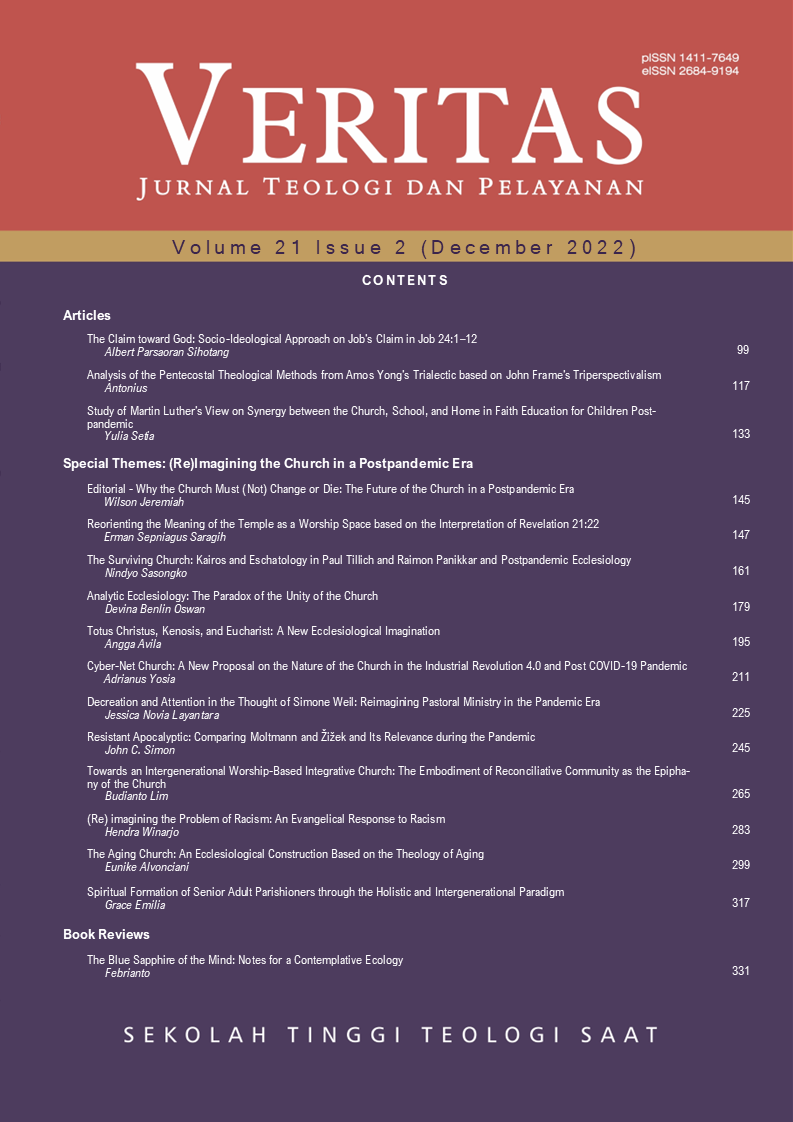Reorienting the Meaning of the Temple as a Worship Space based on the Interpretation of Revelation 21:22
DOI:
https://doi.org/10.36421/veritas.v21i2.588Keywords:
Temple, Worship Space, New Jerusalem, ApocalypticAbstract
The Covid-19 pandemic has raised doubts about the sacredness of places, spaces, and materials for worship celebrations by the church. As a manifestation of God’s kingdom on earth, the church seems to reduce the space for encountering sacred and profane things with God. This article argues that even though the church is the arbitrator of the congregation with God (sacred and profane), the dynamics of the history of the Temple, the physical building is not legal-sacred worship because Christ is the final form of the Temple and believers participate in the New Jerusalem era. The conclusions are: first, the absence of an eschatological temple as part of the anti-Temple and anti-Temple polemic in various segments of Judaism and Greco-Roman, although, of course, the expectation of an eschatological temple was a reasonable expectation for early Jewish eschatology. Second, for Christians in Asia, the function of the physical Temple is not so essential in worship celebrations. However, the involvement of the container in the history of their belief is necessary. Third, John’s eschatological Temple emphasizes a new paradigm shift regarding Divine ownership in their minds, not the imagination of immortal things. Thus, the congregation as performers are not limited by symbols of worship and practicing spirituality must be able to transcend the symbols of worship from time to time.
Downloads
References
Aune, David E. Revelation 17–22. Word Biblical Commentary 52c. Nashville: Thomas Nelson, 1998.
Bauckham, Richard. The Climax of Prophecy, Study on the Book of Revelation. Edinburgh: T&T Clark, 1993. DOI: https://doi.org/10.1017/CBO9780511819858
Beale, G.K. dan David H. Campbell. Revelation: A Shorter Commentary. Grand Rapids: Eerdmans, 2015.
Browning, W.R.F. Kamus Alkitab: A Dictionary of the Bible. Panduan Dasar ke dalam Kitab-Kitab, Tema, Tempat, Tokoh dan Istilah-Istilah Alkitabiah. Jakarta: BPK Gunung Mulia, 2007.
Cherry, Constance M. The Worship Architect: A Blueprint for Designing Culturally Relevant and Biblically Faithful Services. Grand Rapids: Baker Academic, 2010.
Bratcher, Robert G. dan Howard A. Hatton. Pedoman Penafsiran Alkitab: Wahyu Kepada Yohanes. Jakarta: Lembaga Alkitab Indonesia, 2009.
Brown, Colin, ed. The New International Dictionary of New Testament Theology. Volume 1. Grand Rapids: Zondervan, 1975.
Brown, Raymond E. An Introduction to the New Testament. New York: Doubleday, 1997.
Dumbrell, William J. The End of The Beginning: Revelation 21–22 and the Old Testament. Eugene: Wipf & Stock, 2001.
Fiorenza, Elisabeth Schüssler. The Book of Revelation: Justice and Judgment. Minneapolis: Fortress, 1998.
Harker, Ryan D. “Intertextuality, Apocalypticism, and Covenant: The Rhetorical Force of the New Jerusalem in Rev 21:9–22:5.” Horizons in Biblical Theology 38, no. 1 (2016): 45–73. https://doi.org/10.1163/18712207-12341315. DOI: https://doi.org/10.1163/18712207-12341315
Kenyon, Kathleen M. Archaeology in the Holy Land. Edisi ke-4. London: W.W. Norton & Co, 1979.
King, Fergus J. “Revelation 21:1–22:5. An Early Christian Locus Amoenus?” Biblical Theology Bulletin 45, no. 3 (2015): 174–183. https://doi.org/10.1177/0146107915590766. DOI: https://doi.org/10.1177/0146107915590766
Lee, Pilchan. The New Jerusalem in the Book of Revelation : A Study of Revelation 21–22 in the Light of Its Background in Jewish Tradition. Tübingen: Mohr Siebeck, 2001.
Mathewson, David. A New Heaven and A New Earth: The Meaning and Function of the Old Testament in Revelation 21:1–22. JSNTSup 238. New York: Sheffield Academic Press, 2003.
Moss, Candida R., and Liane M. Feldman. “The New Jerusalem: Wealth, Ancient Building Projects and Revelation 21–22.” New Testament Studies 66, no. 3 (2020): 351–366. https://doi.org/10.1017/S0028688520000053. DOI: https://doi.org/10.1017/S0028688520000053
Osborne, Grant R. Spiral Hermeneutika: Pengantar Komprehensif Bagi Penafsiran Akitab. Surabaya: Momentum, 2012.
Patty, Febby Nancy. “Kritik Terhadap Ideologi Imperial: Memaknai Simbol Yerusalem Baru dan Fungsinya dalam Wahyu 21:9–27.” Kenosis: Jurnal Kajian Teologi 1, no. 1 (2015): 1–14. https://doi.org/10.37196/kenosis.v1i1.19. DOI: https://doi.org/10.37196/kenosis.v1i1.19
Perkins, Pheme. Reading the New Testament: An Introduction. Edisi ke-2. New York: Paulist Press, 1988.
Rachman, Rasid. “Perjamuan Awal Jemaat Korintus: deipnon, poterion, symposion.” Tesis, Sekolah Tinggi Filsafat Theologi Jakarta, 2018.
Rachman, Rasid. “Tata Ruang Dalam Gereja Yang Secara Liturgis Menarasikan Karya Allah.” Theologia In Loco 3, no. 1 (2021): 57–81. https://doi.org/10.55935/thilo.v3i1.213. DOI: https://doi.org/10.55935/thilo.v3i1.213
Robinson, Andrea L. Temple of Presence: The Christological Fulfillment of Ezekiel 40–48 in Revelation 21:1–22:5. Eugene: Wipf & Stock, 2019.
Timo, Eben Nuban. Pemberita Firman Pencinta Budaya: Mendengar Dan Melihat Karya Allah Dalam Tradisi. Jakarta: BPK Gunung Mulia, 2006.
Van den End, Thomas. Tafsiran Alkitab Surat Roma. Jakarta: BPK Gunung Mulia, 1995.
Witherington, Ben, III. Conflict and Community in Corinth: A Socio-Rhetorical Commentary on 1 and 2 Corinthians. Grand Rapids: Eerdmans, 1995.
Downloads
Published
How to Cite
Issue
Section
License
Copyright (c) 2022 Erman Sepniagus Saragih

This work is licensed under a Creative Commons Attribution-NonCommercial-ShareAlike 4.0 International License.













